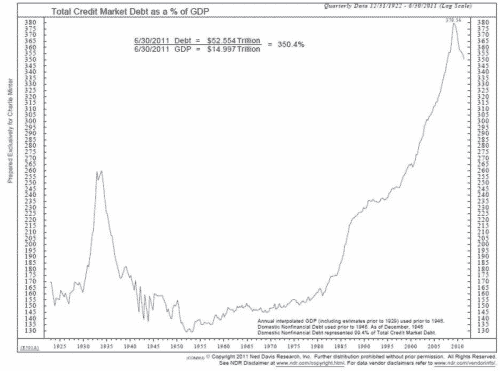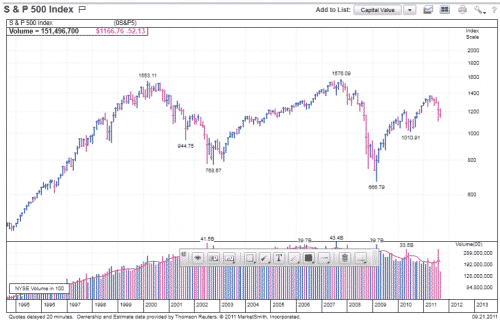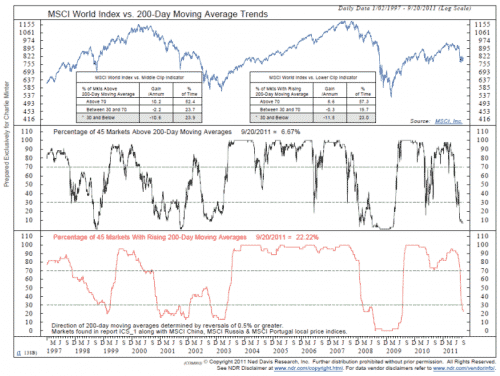Total Private Market Debt’s Decline Should be a Glaring Warning Sign
By Comstock Partners
As the nation experienced the Great Depression beginning in 1929, Total Credit Market Debt as a percentage of GDP rose substantially before eventually collapsing. The years following the ’29 crash were characterized by the most dramatic rise in public debt (and decline in private debt) the nation has ever seen. Beginning in the 1980’s total debt began to expand dramatically until the Total Credit Market Debt hit 380% of GDP in early 2009. Subsequently (just like in the Great Depression), the private debt started to decline while the public debt was rising. (See chart by Ned Davis Research).
The decline in debt/GDP from this level is a signal that we are headed for another period of apprehension about investing, apprehension about borrowing, apprehension about the markets and apprehension about the direction of the country. Extended periods of apprehension, disinvestment and caution lead to deflation and deflation is much worse than inflation or disinflation because the economy, if history is our guide, will enter a severe recession or depression. Prices going down and the consumers waiting to buy is treacherous for the economy.As you can see, the debt/GDP rose to 260% in the Great Depression, before eventually declining to 130% 15 years later. We believe we entered a secular bear market in 2000 when the dot com bubble burst. The debt-to-GDP rose to 380% as we entered the financial crisis in 2008 and, so far, that has been the peak as private debt has dropped more sharply than public debt rose, and the debt to GDP ratio rolled over to 350% currently. Why wouldn’t that be a glaring warning sign that the deflation that we continually warn our readers about is right in front of us?
We think that another cause of concern should be the way the stock market has rolled over with the latest three significant rallies of the S&P 500 filled with "froth" as described below. As you can see from the second chart attached, created exclusively for Comstock by Ned Davis Research, each major component of the economy is retrenching except the Government. But the Government, traditionally the "investor of last resort," is tapped out. Not just tapped out, but the country is trapped in an ideological struggle regarding how to move forward. Can you say"impasse"?
We see a vicious downward spiral operating here. The commercial private sector is not investing, or borrowing, because it does do not see increasing demand for goods and services, broadly speaking. Quite the reverse; in fact, they fear declining demand and, as a result, are sitting on record levels of cash. So why are we surprised that they are not hiring!! The consumer sector sees a stagnant or declining job market and is retrenching and repairing its balance sheets. State and local governments will have to continue to retrench (read: lay off additional staff) and that will add to the unemployed. This leaves the Federal government in a major dilemma.
We will use excerpts from a prior Comstock Report to explain the second reason (besides the rollover of debt described above) we are so concerned that we are in the midst of a deflationary secular bear market. The latest Comstock "Special Report" titled "Stock Market Volatility since 1994" showed the huge volatility since 1994 and described how the swings to the upside were clearly speculative, debt ridden, and bear market traps. The upswings began with the mid 1990s to 2000 led by the dot com mania, where virtually all stocks traded at valuations levels that were more than extreme. Then the S&P 500 (S&P) started the bear market that we had been expecting since the late 1990s, finally occurring in early 2000 from the 1555 level.However, instead of letting the market fall to attractive levels naturally, accompanied by deleveraging and consumer balance sheets being repaired, the bear market was interrupted by the Fed, the Administration, Congress, Wall Street, greedy realtors, and overly ambitious home buyers. This free market intervention created the second bubble and drove the S&P up from 800 in early 2003 (we had expected it to decline to much lower levels since it was trading at 26 times trailing 12 mo. earnings) to almost double to 1575. That upswing was even harder for Comstock to believe than the dot com mania rally. In fact, we mentioned the housing bubble in almost all of our comments during the period from 2003 to 2007.
Then the "Financial Crisis" hit in 2008 and the market crashed to 666 on the S&P in early 2009. The latest rally took the market back to 1370 on the S&P from the oversold 666 level. Technically, this looks like the market is rolling over and declining from a triple top formation with three bear market rally traps (see chart from MarketSmith). We will be shocked if we have another speculative rally like the last three -investors just can’t be fooled four times in such a short period of time.
If you take a look at the MSCI World Market chart attached (courtesy of Ned Davis Research) you will see that world markets have a similar pattern to the S&P 500 chart.Both of these charts (S&P and world markets) look like triple tops
This triple top formation that started with the end of the greatest bull market in U.S. history from 1982 to 2000 (even with a crash in 1987) also followed an enormous increase in debt during this same bull market. Then the total debt, both public and private combined, really accelerated and more than doubled from 2000 to 2008 (going from $26 trillion to $53 trillion). The Public debt increased because we experienced two unfinanced wars, and an unfunded Medicare Part D drug program (with demographics working strongly against us). The Private debt increased because the Fed lowered rates and created a housing bubble and the investment banks securitized anything and everything with a cash flow. Lending standards completely collapsed as zero equity (and worse) loans became the new standard based on the fictional concept that the value of everything would continue to rise, especially housing and real estate. Until it didn’t! While government debt continues to explode, the private sector debt has "hit the wall" and is declining even more with the consumer deleveraging. This decline in private sector debt we would have thought would engender trepidation to outright fear or even panic with investors, but so far this is not even mentioned in the financial media.
The implications for the markets are clear. The earnings estimates on the S&P must go down significantly. With the problems in Europe, and then the potential slow-down in China (after building more residential and commercial construction than presently needed) we would have to think that declining investment (debt) would be even more cause of concern. In our opinion, the stock market is headed to much lower levels, and as we stated before, any upswing will not exceed the 1250 resistance level of the S&P, and any rally should be sold.



Re: investors just can’t be fooled four times in such a short period of time.
No, but testosterone fueled speculators rolling in bazillions of leveraged “liquidity” could.
Dude, lets do another line, and bet it all on black! Dude, like, TOTALLY!
I have seen the debt to GDP chart many times. Facinating when you look at this chart. Debt was sky high during the depression and actually decreased considerably during WWII !!!
And than steady low debt for 30 years. And than rising debt for 30 years.
Is it as simple as credit booms cause busts, and low debt enables sustainable prosperity?
I do not see the bear market as starting in 2000 as a consequence of the tech bubble bursting. That date appears to be a way of making it look good in that there since bear markets usually last 15 years it would at a stroke knock ten years off the time remaining before a recovery. I still think 2008 is the start but because there has been extend and pretend that we need to just add the last four years as a stalling measure. So we still have fifteen years of a downturn, and it looks like the downturn has only just started.
In some respects if we get have to get the overall debt down to a level that we had prior to the 80’s then we could have an even longer decline. You only have to see the first graph to see how much debt needs to be either written off or paid down. This could be done much faster with write-offs but this would mean the end of the big banks, and would require governments nationalising the banks temporarily till they are re-capitalised. Banks would be hard to privatise for a decade, plus the ideological objections to nationalisation even if temporary might simply make that option unpalatable for some. So that means a much longer slow decline in a Japan style malaise but without the government support. So this will get messy. It will be bankruptcy after bankruptcy for years as companies struggle to keep going.
Of course the collapse in Debt/GDP is not the problem, it is the explosion of Debt/GDP that occurred prior to the inevitable collapse. Ponzi financing, as Minsky said.
Debt/GDP rose substantially before collapsing in the first Depression because the denominator was collapsing. GDP has been floated on government debt in this one.
The debt-deflation cycle has been in effect for several years. CPI and PPI have been elevated because of commodity prices, probably speculation.
Ben Bernanke’s hypothesis that saving the banks would avert the depression has come up “rejected” after this experiment.
Since we didn’t fix the banks the first time around, it will have to be done now. As as David says, this requires “the end of the big banks,” and let’s see the “twist” in the GOP on that one.
Somehow I do not see the politicians having the balls to let the banks collapse. There are far too many Goldman Sachs staff in government who would find ways to justify impaling the tax payer gains for many more trillions of support japanese style just so that the big banks can carry on as normal. There will probably be a stepping up of lobbying to support this as the alternatives are a collapsed financial system for a weekend at least.
The UK had started with the right idea of having a living will for banks so that if they collapse then they can be broken up easily or saved more easily. Though I do not think that they have even set a date for this to happen. In fact the recent report into the banking system could be out of date within a year even though it was supposed to guarantee a safer UK banking system by 2019.
I do find it incredible that a so called expert on the last Depression has got it so wrong with this banking collapse.
He was an expert selected by the banks. They went looking for one they liked. Similarly, Greenspan was selected by Reagan because he didn’t like regulation.
I recently found a second cruciaL graph that fits with the economic history of the past 30 years, about numbers of people incarcerated in the USA for the past several decades:
https://timinglogic.blogspot.com/2011/09/economic-realities-created-by-pigmen.html
There is a very obvious incarceration bubble starting in the 1980s just about at the same same as the debt bubble started.
My current hypothesis is that in 1980 politicians in many anglo countries decided to win elections by pandering to swing voting authoritarian leaning petty bourgeoisie (mostly female) asset owners, whereas in 1940-1980 they had been pandering to italian/jewish/irish working class men (resulting in a unionization bubble); this switch of the critical constituency was also accompanied by the switch from manufacturing to FIRE as the leading faction among the purchasers of politicians of both parties.
“The debt-to-GDP rose to 380% as we entered the financial crisis in 2008 and, so far, that has been the peak as private debt has dropped more sharply than public debt rose, and the debt to GDP ratio rolled over to 350%”
Yes, and I have seen somewhere an even more interesting version of the total-debt-vs-GDP ratio: one where there is a line in the middle that shows the very distinct profiles of private vs. public debt over the same time.
Another fascinating graph that I have seen very occasionally from Barry Ritholtz is amount of debt for margin buying in the stockmarket.
Other interesting graphs to accompany would be price/rent ratio in the residential and commercial markets and price/sales and price/earnings ratios for the stockmarket.
“incarceration bubble starting in the 1980s just about at the same same as the debt bubble started.”
I also have the impression that there are actually two turning points (the aim was ever upwards! :->) in most financial trends, one around 1980 and an even stronger one around 1995. The 1995 vertical climb in debt trends was largely due to bank capital leverage deregulation (which in effect recreated wildcat banking) as well as insanely loose monetary policy.
But 1980 and 1995 are also important years in the political calendar (even if arguably the bank capital leverage deregulation policy started during the Clinton administration).